Embouchure: Unterschied zwischen den Versionen
| Zeile 37: | Zeile 37: | ||
==Reed Above – Maxillary Embouchure== | ==Reed Above – Maxillary Embouchure== | ||
[[Datei:Illustration of clarinets.jpg|mini| | [[Datei:Illustration of clarinets.jpg|mini|x255px|links|Eric Hoeprich, Illustration of instruments]] | ||
[[Datei:P. Krämer, sans titre. Mödling, privat collection.png|mini|x275px|rechts|P. Krämer, ohne Titel. Mödling, Privatsammlung]] | [[Datei:P. Krämer, sans titre. Mödling, privat collection.png|mini|x275px|rechts|P. Krämer, ohne Titel. Mödling, Privatsammlung]] | ||
Version vom 25. April 2021, 19:49 Uhr
While the word embouchure in French and English (Italian imboccatura, Spanish embocadura) emphasizes the active "wrapping" of the mouthpiece with the lips, the German word “Ansatz” additionally implies the placement of the instrument in the mouth by the manner of holding. The shape of the embouchure has a decisive influence on the quality of attack and articulation, articulation, legato, timbre, and dynamics. The type of embouchure shape determines the endurance when playing a wind instrument and the pressure of the embouchure influences the intonation.
Contributions by the Interviewees
- Michel Arrignon
- Paolo Beltramini
- François Benda
- Alain Billard
- James Campbell
- Philippe Cuper 1, 2
- Alain Damiens
- Eli Eban
- Steve Hartman
- Sylvie Hue
- Gerald Kraxberger
- Seunghee Lee
- Harri Mäki
- Heinrich Mätzener
- Ernesto Molinari
- Pascal Moraguès
- John Moses
- Thomas Piercy
- Frédéric Rapin
- Milan Rericha
- Ernst Schlader
- David Shifrin
- Richard Stoltzman
- Jérôme Verhaeghe
- Michel Westphal
Historical Sources
The embouchure technique in use today, in which the reed lies on the lower lip and the upper teeth touch the mouthpiece, has undergone a long development. Knowledge of and experimentation with earlier forms of embouchure technique increase the flexibility of all aspects of embouchure. The position of the lower jaw, the shape and tension of the lip muscles, the shape and position of the tongue, and the shape of the oral cavity all play a role.
Gianluca Campagnolo (2019)[1] gives an overview of the various embouchure techniques as documented in the clarinet methods of the late 18th and 19th centuries. He summarizes that the beginning of the 19th century saw a discussion of "reed above, maxillary embouchure" or "reed below, mandibular embouchure" which, in Italy, continued until the 1920s (see[1]).
In the second half of the 19th century, playing with the reed below became established practice, and discussions began to revolve around the question of single-lip or double-lip embouchure. Since about 1945, double-lip embouchure players have become rare. Discussions of "correct" embouchure technique referred to factors such as sound quality, clarity and variability of articulation, and freedom of finger technique. Developments in instrument making also favored one or the other playing technique.
Reed Above – Maxillary Embouchure
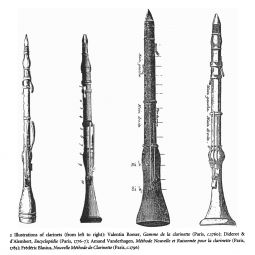

Illustrations in treatises and methods of the 18th century confirm that until about 1810 the clarinet was played with the reed pointing upwards so that it touched the upper lip (Hoeprich 2009 )[2]. Corresponding to the way the oboe and bassoon were played – often these musicians also played the clarinet – this was the obvious technique: mouthpiece and reed were covered by the upper and lower lip (see Michel Blazich, 2014)[3]. The mouthpieces of the instruments of that time were also considerably slimmer, and boxwood instruments with only five keys did not have the weight of a modern clarinet, so that a double-lip embouchure proved unproblematic. This type of embouchure, called "Übersichblasen", "Obersichblasen" (Pearson 2018)[4] or "Ober dem Kopf" [Over the head] (Joseph Fröhlich, 1811)[5] in the historical instructional works, is also referred to in the specialist literature (Heinz Becker, 1978)[6] as a maxillary embouchure (from the Latin maxilla, the upper jaw). The maxillary embouchure influences the shape and position of the tongue as well as the shape of the oral cavity: in order to be able to articulate on the reed, the tip of the tongue must point forward and upwards to touch its outermost edge. If the tongue were to remain in its natural position, any movement would only touch the mouthpiece and would not interrupt the vibration of the reed (see Articulation). This tongue position is associated with opening of the throat and increase of the volume of the rear oral cavity. Joseph Fröhlich (1811) values the tonal advantages gained in this way. He recommends avoiding the difficulty of articulating with the tongue by articulating "with the chest." Maxillary embouchure was taught in Paris in the late 18th century and until the 1820s, during which time Amand Vanderhagen (1785)[7], Frédéric Blasius (1796)[8] und Jean-Xavier Lefèvre (1803)[9] published comprehensive teaching works.
„Il faut appuyer le bec sur la lèvre inférieure, couvrir l’anche de la lèvre supérieure, sans que les dents y touchent en aucun cas car les dents ne doivent que soutenir les lèvres et leur donner la force nécessaire pour pouvoir pincer dans les tons hauts.“
„"The mouthpiece should be pressed against the lower lip, covering the reed with the upper lip without the teeth touching it under any circumstances, since the teeth should only support the lips and give them the necessary force to be able to reach in high tones."“
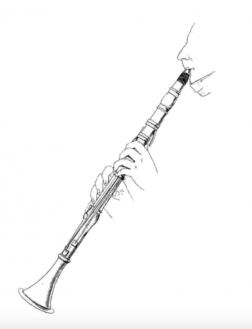
In Italy, clarinetists continued using the reed above, and the method was in evidence until the middle of the 20th century. Ferdinando Busoni (1866-1925)[10], the father of composer Ferrucio Busoni, considered it to be the only correct method, because the sound in contact with the weaker upper lip was softer and far more capable of modulation, the possibilities of shading were greater, and the intonation was cleaner. The most important representatives of the "Neapolitan School,"[11] which is close to the Bel Canto, are Ferdinando Sebastiani[12] (1803-1860), and his student Gaetano Labanchi (1829-1908). In addition to the tonal advantages and the broader articulation possibilities offered by the maxillary embouchure Gaetano Labanchi emphasizes the great dynamic possibilities, including the fading of the pianissimo:
„Si può talmente assottigliare da produrre i suoni di un'eco piu o meno lontano comecchè si voglia.“
„“In this way one can refine the sound production to such an extent that one can play the notes as one wishes in an echo that sounds closer or further away.”“
Reed Below – Mandibular Embouchure
Playing with the reed below – or "Untersichblasen" (Backofen, 1824)[14]– the reed touches the lower lip, while the upper lip covers the upper teeth and envelops the mouthpiece. This type of embouchure, also called mandibular embouchure[6] (from Latin mandibula, the lower jaw), was first recommended by the Norwegian bandmaster Lorents Nicolai Berg (1782)[15]. Gianluca Campagnolo (2019)[1] shows that this playing technique had already been spreading in the German-speaking world since the end of the 18th century, replaced the maxillary approach in France around 1830, and was also being used in England. As with the maxillary approach, there is also a finger technique connected with the mandibular approach, which often uses "supporting fingers." In this technique, various tone holes that do not cause a pitch change are covered. In combination with the right thumb, the supporting fingers play a role in holding the clarinet. As part of the embouchure technique, a gentle pressure can be built up with the right hand in the direction of the embouchure and reed. Activating the masticatory muscles (Musculus masseter) would exert pressure on the upper lip at the most unfavorable angle and injure it.
Heinrich Baermann celebrated great success as a soloist in Paris in 1817/18, playing with the reed below. Frédéric Berr, professor at the "Conservatoire National de Musique" from 1831-1836, was fascinated by the dynamic and tonal possibilities of this embouchure technique and introduced it as the standard in France. He did, however, retain the "wrapping of the mouthpiece" with the upper lip.
„Le célèbre Baermann nous a fait entendre en 1818 à Paris des sons pianissimo qui étaient tout-à-fait inconnus en France. Il jouait des phrases de quatre mesures avec beaucoup de force, et il les répétait en écho tant de douceur qu’on aurait cru que les sons venaient d’une salle voisine...
Je conseillerais de tenir en garde contre une mauvaise habitude qui existe en Allemagne: c’est de mordre sur le bec. Ce défaut donne une mauvaise qualité de son, et nuit à la flexibilité de l’expression.“
„"The famous Baermann let us hear pianissimo sounds in Paris in 1818, which were completely unknown in France. He played four-bar phrases with great power and repeated them with such a gentle echo that one might think the sounds were coming from a neighbouring room... However, I advise you to be careful of a bad habit that occurs in Germany: biting the mouthpiece. This mistake gives a bad sound quality and destroys the flexibility of expression.”“
In Paris, Frédéric Berr was followed by several generations who continued to use this technique until the 20th century: Hyacinthe Klosé (1808-1880)[17], Cyrille Rose (1830-1902), Charles Turban (1845–1905), Prosper Mimart (1859-1928)[18] and finally Gaston Hamelin (1884-1951), who did important pedagogical work in the USA.
The Méthode of (1829)[19] proves that the method of supporting the upper teeth on the mouthpiece was already in use in the 19th century. Carnaud recommends that beginners try out both types of embouchure and decide for themselves which type is more suitable for their individual requirements (size of lips and teeth). The same view is held by Eugène Gay (1932) (1829)[20]. This type of approach then became the standard in France as well.
The technique of the mandibular embouchure, most likely still a double-lip embouchure, was likely practiced by Joseph Beer (1744 - 1812) and passed on to his students in the German-speaking world, Franz Tausch (1762 - 1817) and Heinrich Baermann (1784 - 1847).
From Iwan Müller and Carl Baermann to Today's Playing Technique
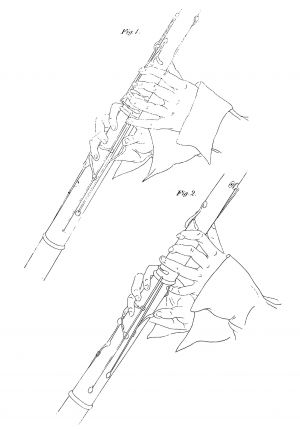
In 1812 Iwan Müller[21] patented his new clarinet, which was augmented to 13 keys, and around 1826 he wrote the instructions for the new clarinet. He recommended playing with the reed down, but in connection with new keys for the thumb on the right, but also with the teeth on the mouthpiece. This became necessary because the right thumb had to operate the keys placed on the back of the instrument and therefore needed more freedom of movement.
„Mehrere Gründe raten indessen, das Blatt auf die Unterlippe zu legen (unten zu blasen) denn 1.) der Daumen der rechten Hand wird frey, und braucht die Clarinette nicht zu halten. Hierdurch fällt ein Mangel der alten Clarinette weg, weil man jetzt, vermittelst des freyen Daumens, h und cis, c und es, so wie h und dis und des und es , oder umgekehrt, binden (schleifen) kann [...] Dieser Vortheil wird bey dem Obenblasen schwieriger. 2.) man kann auf die Zähne der unter die Kinnlade ein Stückchen Papier legen, damit die Zähne die Lippe, auf welcher das Blatt ruhet, nicht verwunden. Bey dem Oberblasen leidet die Lippe allemal. 3.) Der Spieler vermeidet die Anstrengung der Gesichtsmuskeln und Züge, welches nicht der geringste der angegebenen Vortheile ist, indem der Spieler auch darauf sehen muss und dem Zuhörer keine unangenehme und peinliche Empfindung zu verursachen. Bey dem Oberlasen kann der Spieler keine völlig ruhige Mine behalten, denn die Oberlippe ist zu klein, dass sie die Zähne leicht ungezwungen bedecken könnte.“
„"There are several reasons for placing the reed on the lower lip (blowing underneath): 1) the thumb of the right hand becomes free and does not need to hold the clarinet. This eliminates a defect of the old clarinet, because now, by means of the free thumb, one can connect (slide between) b and c sharp, c and e flat, and b and d sharp and d flat and e flat [...] This advantage becomes more difficult when blowing on top [reed above]. 2) a piece of paper can be placed on the teeth of the lower jaw so that the teeth do not wound the lip on which the sheet rests. The lip suffers in any case during the blowing above. 3.) The player avoids straining their facial muscles and movements, which is not the least of these advantages, in that the player must also be conscious of not causing the listener to feel uncomfortable and embarrassed. With the upper lip, the player cannot keep a completely calm lead, because the upper lip is too small to easily cover with the teeth.“
When playing with double-lip embouchure, the right thumb had to be used in combination with the holding work, and both lips were loaded approximately equally (the upper lip was slightly stronger due to the resulting torque). The fact that Iwan Müller recommends placing a protective paper between the teeth and the lower lip indicates that the new thumb flaps meant that the supporting function of the right thumb was relegated to the background, and that the embouchure was now more involved in the holding and was therefore subjected to greater pressure.
In the first edition of his Anweisung (1803)[14], Heinrich Backofen leaves it up to each individual player to decide whether to "blow above” or “blow below." In the second edition (1824)[22] which he wrote for the further developed "Inventions-Klarinette" with twelve keys, he refers to the clarinet by Iwan Müller with respect to embouchure, and points out that playing with a maxillary embouchure was no longer possible because of the added thumb caps.
„[...] Von Iwan Müller [wurden] noch zwei Verbindungen mit der Cis und Dis Klappe angebracht, welche durch den Daumen der rechten Hand regiert werden können. [...] Allein ob diese Verbindungen sehr zweckmässig sind, so sind sie es doch nur für diejenigen, welche unter sich (nämlich das Blättchen auf die untere Lippe gelegt) blasen; für die andern aber, welche das Blättchen unter die Oberlippe legen, und deren es wohl ebenso viele gibt, ist diese Methode unausführbar, denn für die ersten reicht der Daumen der linken Hand hin, um die Clarinette zu unterstützen; letztere brauchen aber hierzu noch den Daumen der [wohl hier irrtümlich] linken Hand [es muss die rechte Hand gemeint sein]. Wollen sie nun mit diesem die Verbindungsklappen gebrauchen, so muss der Ton für diesen Augenblick unterbrochen werden, weil durch das Gewicht des untern Teils der Clarinette das Blättchen an die Oberlippe und ganz zugedrückt wird.“
„"[...] Iwan Müller [added] two more connections with the C# and D# keys, which can be controlled by the thumb of the right hand. [... But whether these connections are very practical, they are so only for those who blow underneath themselves (namely, those who place the leaflet on the lower lip); for the others, however, who place the leaflet under the upper lip, and of whom there are probably just as many, this method is impracticable, because for the former, the thumb of the left hand reaches out to support the clarinet; but the latter still need the thumb of the left hand for this [probably erroneously here, the right hand must be meant]. If they now want to use the connecting keys with the latter, the sound must be interrupted for this moment, because the weight of the lower part of the clarinet presses the reed against the upper lip and closes it completely.”“
The change in the embouchure technique when playing the Iwan Müller clarinet had no sonic reasons, but became necessary as a result of technical innovations in fingering. This may have been the reason why Iwan Müller's invention did not find the hoped-for acceptance in Paris.
Carl Baermann (1861)[23], the son of Heinrich Baermann, considers embouchure to be "the most important thing for tone formation, indeed it is actually tone formation itself.” He was an uncompromising advocate of "reed below." In contrast to the doctrines widespread in France and England, the upper teeth and not the upper lip had to touch the mouthpiece. To protect the wooden mouthpiece from wear and tear, it was protected by a silver plate. Baermann considered the alleged tonal advantages of the double-lip approach to be self-deception:
„[...] diese Anblasart ist natürlicher und zweckmässiger [...] da die Ausdauer und daher in notwendiger Folge die Sicherheit wenigstens die doppelte ist [...] Viele Klarinettisten spielen die Ober- und Unterlippe über die Zähne gezogen, wodurch der Ton dem Bläser selbst, jedoch nur scheinbar, weicher klingt. [...]“
„"[...] this type of blowing is more natural and more appropriate [...] because the endurance and therefore the reliability is at least doubled [...] Many clarinetists play with the upper and lower lip pulled over the teeth, which makes the sound softer to the wind player, but only apparently. [...]““
Embouchure Today – Contributions by the Interviewees
With the type of embouchure usually seen today, the reed lies on the lower lip and the upper teeth touch the mouthpiece. By activating the lip muscles and in interaction with other parts of the facial musculature, the lower lip forms a cushion that clings to the lower teeth. The combination of the facial muscles seals the base well so that no air escapes at the corners of the mouth during sound production. The lower lip should neither be pulled over the teeth nor stretched to the side.
The upper and lower lips close around the mouthpiece in a ring, so that the airflow can be focused on the mouthpiece and reed. (François Benda, Milan Rericha, Paolo Beltramini, James Campbell, Alain Damiens, Eli Eban, Gerald Kraxberger, Seunghee Lee, Ernesto Molinari, Harri Mäki, Frédéric Rapin, Ernst Schlader, Jérôme Verhaeghe).
Muscle activations and its Functions
All muscle activations outlined below should be used moderately and in a carefully balanced manner. Keith Stein (1958, ""Relaxation")")[24] points out that descriptions of embouchure formation carry the danger of being applied with too much force. It is always a challenge to exert a lot of force with certain muscles, such as breathing muscles, while simultaneously activating other muscles in a very targeted manner and with the least amount of effort. Getting to know the different actors in isolation, so that they can then be used independently of each other, is an important learning step in embouchure formation.
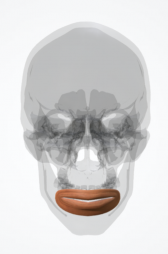
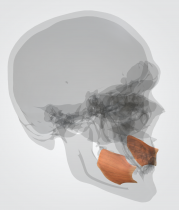
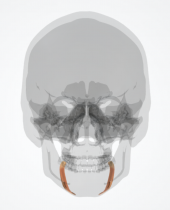
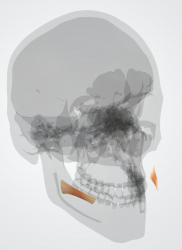
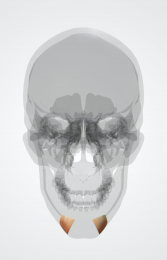
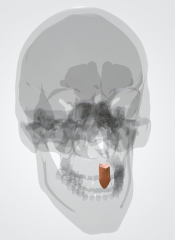
The Musculus orbicularis oris anatomically encompasses the upper and lower lip. Its activation closes the lips; if only the outer parts are active, the lips are shaped as if for kissing.
All interviewees mention the activation of the lip muscles as one of the most important principles of embouchure. Joe Allard[25] adds an important aspect to this: he connects the use of the M. orbicularis with the embouchure line and the oscillation of the reed, which must remain as free of pressure on both sides as possible. Care must be taken to insert the M. orbicularis without lifting the mandible. This would result in too tight a fit around the mouthpiece and would exert too much pressure on the rails of the reed and dampen important overtones there. The amount of force used should be only enough to prevent air from escaping laterally.
Joe Allard avoids exerting pressure on the reed from below and takes special care that the lower lip does not take a bowed shape against the reed. This would impair the vibrations on both sides of the reed. The sealing of the mouthpiece is therefore done with the upper lip.
The Musculus orbicularis oris anatomically encompasses the upper and lower lip. Its activation closes the lips; if only the outer parts are active, the lips are shaped as if for kissing.
All interviewees mention the activation of the lip muscles as one of the most important principles of embouchure. Joe Allard[26] adds an important aspect to this: he connects the use of the M. orbicularis with the embouchure line and the oscillation of the reed, which must remain as free of pressure on both sides as possible. Care must be taken to insert the M. orbicularis without lifting the mandible. This would result in too tight a fit around the mouthpiece and would exert too much pressure on the rails of the reed and dampen important overtones there. The amount of force used should be only enough to prevent air from escaping laterally.
Joe Allard avoids exerting pressure on the reed from below and takes special care that the lower lip does not take a bowed shape against the reed. This would impair the vibrations on both sides of the reed. The sealing of the mouthpiece is therefore done with the upper lip.
Closed Corners of the Mouth – and Pointed Chin
If the M. orbicularis is activated alone, the lips are turned slightly forward. In order to surround the mouthpiece in a ring shape and prevent air from escaping, the corners of the mouth are retracted laterally and the lips are snuggled closely against the upper and lower rows of teeth (David Shifrin). This requires the use of additional facial muscles ((Eli Eban)). These muscles can be exercised in isolation and in combinations, even without an instrument (Harri Mäki, James Campbell 1, 2). The facial muscles form a complex network that is interwoven even without activation. The simultaneous and balanced activation of the following muscles creates the stability necessary for an embouchure that can direct air pressure and air flow velocity to the reed for efficient sound production.
James Campbell describes a triangle that can be fixed between three points, the two well closed corners of the mouth and the tip of the chin. Following the lessons of Robert Marcellus, he also speaks of the "Marcellus triangle" or "Marcellus has a mustache" (sound example). Other advocates of this technique are: Seunghee Lee, David Shifrin.
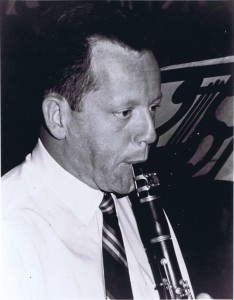
Caution: A flat chin should only be a means to an end. If the M. risorius works too hard and the two M. orbicularis and M. Musculus depressor anguli oris are too weak, it is easy to make a flat, pointed chin. The lower lip is then stretched sideways and air escapes from the corners of the mouth. This is often compensated for by biting the mouthpiece.
John Moses therefore warns against forming a pointed chin. Thomas Piercy sees no need to concentrate on forming a flat, pointed chin: too much of the effort is involved in stretching the embouchure sideways. If, on the other hand, the advantages of the double-lip approach are transferred to the simple embouchure, this discussion is unnecessary. Eli Eban points out a favorable concatenation of muscle activations: directing the tip of the tongue forwards/upwards, automatically results in a flat chin.
Air Pressure – Air Speed – Embouchure Pressure
When the embouchure is formed and the airflow is activated, no sound is emitted, only the sound of the air flowing through can be heard. There are various ways to get the clarinet reed to vibrate. The best tonal result that also maintains conditions suitable for the body is achieved by increasing the air speed at the reed tip.
Increased Air Speed in the Area of the Reed Tip

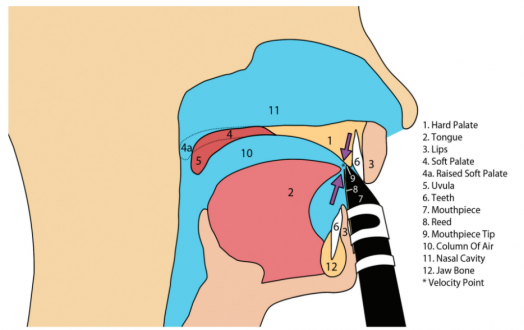
Ron Odrich (2017)[27] shows that positioning the tip of the tongue in close proximity to the tip of the reed significantly increases the air speed. This means that it is not necessary to increase the air pressure at the same time to make the reed oscillate. Ron Odrich refers to Daniel Bernoulli’s law, which states that the flow velocity of a gaseous or liquid substance in a pipe with a narrower diameter increases and the pressure decreases simultaneously. Inversely, it is maintained at a point with a larger diameter: the flow velocity is slower, the pressure higher. The energy is equally high at both points. The reed oscillates more easily when the velocity of the airflow is higher. This is achieved by moving the tongue forwards and upwards at the tip of the blade – almost getting in the way of the air.
The steep angle of the clarinet and the narrow space between the tip of the mouthpiece and the front palate are striking in this illustration. This constellation will change depending on the individual position of the teeth. Without taking into account the different individual constellations of tooth position, lip shape, or reed size, the following applies: if the tip of the tongue is positioned as close as possible to the tip of the reed, the air velocity increases there.
Embouchure Pressure
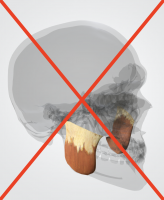
A minimal applied pressure is sufficient to cause the vibration of the reed in combination with the increased air speed in front of the reed tip created by the tongue position. This results in the following possibilities for slightly increasing the pressure without changing the jaw position:
- The activation of the embouchure is emphasized more strongly. The cushion that forms the lower lip becomes more compact, the hold of the M. orbicularis around the mouthpiece somewhat stronger. This technique is recommended by Milan Rericha, Alain Billard, Alain Damiens, Steve Hartman, Frédéric Rapin.
Bernhard Portnoy (1956)[28]adds an interesting aspect to this: depending on how powerfully the M. orbicularis works, the lower lip becomes somewhat more compact and the timbre somewhat brighter and clearer. If the lower lip is somewhat more relaxed, the result is a softer timbre.
- By bringing the instrument closer to the embouchure, the pressure on the reed can be regulated by the manner of Holding the Clarinet. With this technique the embouchure line is shifted slightly downward (see also: James Campbell, Harri Mäki).
The lower jaw is pushed carefully forward/backward through interaction of the pterygoid lateralis muscle (Latin for lateral or outer wing muscle), which pulls the mandible forward, with the mylohyoid muscle, also known as the diaphragm oris, which directs this downward movement (Eli Eban).
Caution, do not bite!
All interviewees advise against using the biting muscle, Musculus masseter, one of the strongest muscles in our body, or recommend at least a very careful use of this muscle. The lower lip is exposed to a very unfavorable angle of pressure and is also at risk of being injured. In addition, the embouchure line at the point of insertion moves upwards on the reed, less area of the reed vibrates, and the sound sounds pressed. None of the interviewees explicitly mention this muscle activation as a necessary part of embouchure formation. It is clear, however, that the lower lip, used as a compact cushion, must absorb a certain amount of pressure. François Benda.
To counteract excessive embouchure pressure, Ernesto Molinari and Ernst Schlader recommend playing on bass clarinet or historical clarinets.
Flexible Embouchure Line
The embouchure line is the point where the reed rests on the lower lip. It determines which part of the reed can vibrate freely. Since the tip of the reed tapers towards the front and since the opening between the reed and the mouthpiece becomes larger towards the tip, the same pressure has a different effect on the vibration of the reed, depending on the position of the embouchure line. Placing the embouchure line where the reed begins to move away from the mouthpiece is recommended ((David Shifrin), however individual physiologies must be taken into account: regardless of the embouchure line, the upper teeth are placed at different positions on the mouthpiece depending on the position of the teeth (Alain Billard, Jérôme Verhaeghe).
In the clarinet school of |Joseph Fröhlich (1811) there is an early source which recommends a different position of the embouchure line depending on the pitch:
„...dass man das Rohr ohne allen Zwang oder merkbaren Absatz immer tiefer bis fast an den Faden in den Mund nehme, indem man mit den Lippen immer fester drückt, ohne den Ansatz selbst zu ändern, denn das muss bloss das Werk der Lippen seyn.“
„"...that one takes the reed into the mouth without any compulsion or noticeable pause, deeper and deeper into the mouth, almost up to the thread, by pressing the lips ever more firmly, without changing the embouchure itself, for this must be the work of the lips alone."“
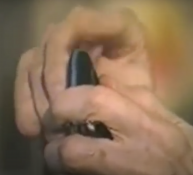
A flexible embouchure was also taught by Gaston Hamelin, a representative of the Old French School in the USA. His former student Joe Allard and Daniel Bonade's student Bernard Portnoy (1956)[28] describe the practical application of a flexible embouchure line in achieving dynamic gradations – with constant intonation: In “ff”, the embouchure is placed a little further down the reed, in pp it is placed further up. And for the purpose of a reliable response in the different registers: in the chalumeau and in the middle register, the embouchure line is placed further up on the reed, in the clarinet register it is a little lower, and in the high register this line shifts a little further down. Equally important for Joe Allard is that the embouchure line does not put unnecessary pressure on the side edges of the reed and dampen the vibration there. This requires a differentiated use of the facial muscles.
Further contributions to this: John Moses, Richard Stoltzman
Martin Spangenberg, professor at the Hanns Eisler Music Academy in Berlin, comments:
„"Die Ansatztechnik, bei welcher der Ansatz durch Druck gegen die oberen Zähne stabilisiert wird, findet bei vielen Klarinettisten erfolgreiche Anwendung. Damit verbindet sich Stabilität im Ansatzbereich. Ich halte es jedoch für notwendig, die Ansatzlinie entsprechend der gespielten Tonlage weiter oben oder weiter unten am Blatt platzieren zu können. Dies bedingt entsprechende Flexibilität bei der Positionierung des Mundstückes. Die Haltearbeit des Instrumentes wird so zum Teil der Ansatzformung, je nachdem wie weit das Mundstück in den Mund angesetzt wird, verschiebt sich die Ansatzlinie auf dem Blatt nach unten oder nach oben. Bei höheren Tönen liegt die Ansatzlinie weiter unten.““
„"The embouchure technique, in which the embouchure is stabilized by pressure against the upper teeth, is successfully used by many clarinetists. This is associated with stability in the embouchure area. However, I consider it necessary to be able to place the embouchure line further up or down the reed according to the pitch played. This requires corresponding flexibility in the positioning of the mouthpiece. Holding the instrument thus becomes part of the embouchure formation; depending on how far the mouthpiece is placed in the mouth, the embouchure line on the reed shifts either upwards or downwards. For higher notes, the embouchure line lies further down." [29]“
Further, it should be noted:
- A more closed jaw position shifts the embouchure line upwards and, accordingly, a smaller area of the reed vibrates; a more open jaw position in combination with the holding position locates the embouchure line further lower on the reed.
- By simultaneously pushing the mandible forwards and downwards, the embouchure line can be placed further down the reed. This technique should be used with caution and according to each individual clarinetist’s tooth position. See also auch François Benda und Keith Stein, Steve Hartman, Sylvie Hue
- The dimensions of the mouthpiece: a slimmer mouthpiece means that more mouthpiece is taken into the mouth while the opening of the lower jaw remains the same, thus shifting the embouchure line downwards.
Blowing Angle
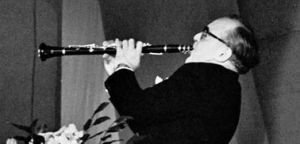
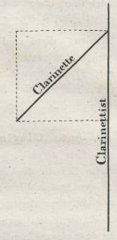
There are various opinions about the angle that the clarinet should form with the body. Frédéric Berr[16], Heinrich Backofen[22], Paolo Beltramini, Joseph Fröhlich, Milan Rericha, John Moses, David Shifrin describe a blowing angle of 40° to 45°. Jean-Xavier Lefèvre (played with double-lip embouchure) points out that too large of a blowing angle makes playing in the high register difficult.
Harri Mäki combines the flexibility of the embouchure line and the angle: he recommends that the angle be narrowed when playing a crescendo, while at the same time pushing the instrument slightly towards the embouchure, to maintains a better tone quality.
James Campbell remembers lessons with Daniel Bonade and makes the connection between a steeper angle, faster air velocity at the tip of the mouthpiece, and a correspondingly singing sound.
Like the embouchure line, the angle of attack must also be considered in connection with the individual physiology. In addition, a head tilted forward can have the same effect as a very wide blowing angle with an upright head position ((Sylvie Hue, Michel Westphal, Alain Damiens)).
Thomas Piercy makes use of this connection and leans his head back a little. This has the same effect as bringing the instrument closer to the body. François Benda, Eli Eban and Frédéric Rapin place the blowing angle in the context of each individual’s teeth and tongue (Benda). Michel Arrignon makes the connection between the angle and dynamics: an open angle allows greater dynamics, but the sound is more difficult to control. The mouthpiece facing configuration also has an influence on the ideal angle.
If the clarinet is held closer to the body, depending on the position of the teeth and the opening of the mouth (jaw position), more mouthpiece must also be placed in the mouth to allow sufficient surface area of the reed to vibrate. When maintaining the same head position, the following can be observed:
- An open angle creates a wider diameter of the airway at the tip of the mouthpiece and resultsin a higher embouchure line (see Flexible Embouchure Line for details)
- A narrower angle causes a greater opening of the jaw position or increases the pressure on the reed, and results in a lower embouchure line. The tip of the mouthpiece is closer to the hard palate, making it possible to create a narrower diameter of the airway at the tip of the mouthpiece, see illustration by Ron Odrich (2017)
Double-Lip Embouchure?
Following the tradition of the Old French School, James Campbell, Eli James Campbell, Eli Eban 1, 2 Heinrich Mätzener, David Shifrin, Philippe Cuper, Pascal Moraguès, Harri Mäki, and Thomas Piercy recommend using the double-lip embouchure for tone formation exercises.
Advantageous Muscle Combinations
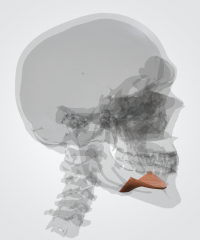

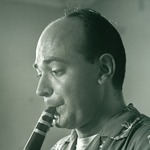
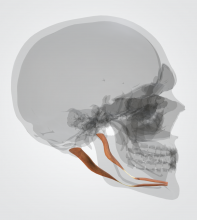
In the case of double-lip embouchure, the shape of the oral cavity as well as the tongue position and shape change automatically. Centering and rolling the lips over the upper and lower teeth so that they do not touch the mouthpiece or the blade triggers further muscle activation in the oral cavity. This activates a constellation of muscles inside the mouth, similar to those that occur when sucking with a drinking straw. The following muscles are involved:
- Musculus mylohyoideus: as after swallowing, it pulls the hyoid bone forward, stretches the floor of the mouth downwards and thus opens the throat.
- Musculus digastricus: this is the name given to the other muscles involved in opening the jaw (abduction of the lower jaw).
- Musculus longitudinalis superior and inferior: both muscles lift the tip of the tongue.
A sound example by Harold Wright,, who studied with Ralph McLane using double-lip embouchure, illustrates this playing technique. Steve Hartman, Richard Stoltzman and Thomas Piercy switched to the double-lip technique after graduation, sometimes after several years of professional practice. The following reasons might have motivated them to make this complex change:
Changes in playing technique
- The shape of the interior of the mouth changes in a beneficial way: while the soft palate lifts and the throat opens, the tip of the tongue automatically finds itself close to the tip of the reed. The speed of the air increases in this area, and the reed can be made to vibrate at lower air pressure (see also Ron Odrich). This constellation is also possible with a normal embouchure, but requires more attention Thomas Piercy.
- Upper and lower lip hold the mouthpiece with the corners of the mouth; there is practically no vertical pressure on the reed Thomas Piercy.
- It is no longer necessary to devote a lot of energy and attention to a flat chin shape, as this is automatically achieved by an advantageous combination of muscles. Thomas Piercy.
Musical advantages
(see also Ralph McLane (1950) in clarinet central)
- Playing legato over larger intervals and register changes becomes easier
- Changes in tone color changes are easier.
- The position of the embouchure line is flexible and can be easily adapted to the various dynamic levels and register positions.
- The intonation can be controlled better; forte passages do not get lower
- The fingering becomes easier and more sensitive to the holding position Thomas Piercy.
Practice with Double Lip, Play with Normal Embouchure
David Shifrin and Thomas Piercy see a great advantage in the fact that complicated explanations regarding the shape of the oral cavity and the shape and position of the tongue are not necessary.
„"I have the students do sound exercises with double-lip embouchure. This is highly recommended for tone formation. Actively enclosing the mouthpiece with both lips will basically bring the tongue into a shape that is favorable for resonance forming. If the tip of the tongue is brought close to the tip of the reed, the resonance shaping is additionally optimized. The necessary tension in the chin ("pointed chin") is automatically adjusted."“
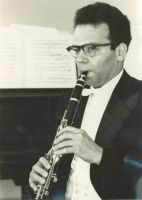
For short, regular practice sequences with double-lip embouchure, the advantages of this type of embouchure can be transferred to the simple, conventional embouchure and combined with its benefits (protection of the upper lip, endurance and stability of the tone). James Campbell adopts the didactic principles of his teacher, Yona Ettlinger and calls the double-lip embouchure the "ideal embouchure." He also has students play tone exercises using double-lip embouchure, in order to then transfer the advantageous shaping of the oral cavity and the strengthening of the lip muscles to the normal embouchure. James Campbell plays concerts with normal embouchure.
Michel Arrignon would only give these tasks to advanced students*, for beginners it would be counterproductive.
Richard Stoltzman would not prescribe the double-lip embouchure to his students.
Tips for Changing from Single- to Double-Lip Embouchure
When using double-lip embouchure, it is a good idea to take a look at the Traité by Frédéric Berr (1832)[16]
„Le Bec, étant ainsi tenu par les deux lèvres avec une légère pression qui s'oppose seulement à la sortie de l'air par les coins de la bouche, doit avoir un mouvement libre: une pression trop forte rapprocherait l'anche de la table et empêcherait la vibration nécessaire à la qualité du son, qui serait court et étouffé. Cependant il faut un peu augmenter la pression pour obtenir les sons aigus.“
„"The mouthpiece, which is thus held by both lips with a light pressure that only prevents air from escaping at the two corners of the mouth, must be able to move freely: too much pressure would press the reed closer to the mouthpiece's path and reduce the vibration necessary for the sound quality, it would break off too early and would be damped. In order to play the high notes, however, it is necessary to increase the pressure a little."“
- Frédéric Berr speaks of a freely moving mouthpiece. This means that the mouthpiece can be moved slightly towards the embouchure through the holding position of the instrument, in order to slightly increase the pressure on the reed for the higher notes (see also Flexible Embouchure Line).
- The jaw always remains in the same slightly open position and the lips envelop ("enveloppent") the mouthpiece. Only minimal pressure is applied. The M. orbicularis closes around the mouthpiece like an optical lens, the parts of the facial muscles nestle the lips close to the teeth and form the lower lip into a compact cushion. At the same time, holding the instrument pushes it a little towards the base. These two forces interact subtly, cf. Eli Eban.
- The subtle increase in pressure shifts the embouchure line slightly downwards on the reed, which improves the way the reed vibrates.
Robert Adams provides a good explanation of double-lip embouchure from today's perspective.
Literature
Methods, Articles
- Johann Georg Heinrich Backofen (1803)[14]
- Carl Baermann (1861)[23]
- Frédéric Berr (1836)[16]
- Gaetano Labanchi (1886?)[13]
- Jean-Xavier Lefèvre (1802)[9]
- Keith Stein (1958)[24]
- Bernard Portnoy (1956)[28]
- Larry Guy: Embouchure Building for Clarinetists: A Supplemental Study Guide Offering Fundamental Concepts, Illustrations, and Exercises for Embouchure Development. Rivernote Press, 2011.
- Larry Guy and Daniel Bonade: The Daniel Bonade Workbook: Bonade’s Fundamental Playing Concepts, with Illustrations, Exercises, and an Introduction to the Orchestral Repertoire. Rivernote Press, 2007.
- David Pino (1998)[32]
References
- ↑ 1,0 1,1 1,2 Campagnolo, Gianluca 2019. Prassi esecutiva e repertorio per clarinetto. Liberiauniversitaria, Padova[6]
- ↑ Hoeprich, Eric. "'Regarding the Clarinet': "Allgemeine Musikalische Zeitung", 1808." Early Music 37, no. 1 (2009): 89-99. Accessed July 9, 2020. www.jstor.org/stable/27655302.
- ↑ Blazich, Joan "Amand Vanderhagen’s Méthode Nouvelle et Raisonnée Pour la Clarinette (1785) and Nouvelle Méthode de Clarinette (1796): Complete Translations and Analyses of the First Classical Clarinet Treatises." Electronic Thesis or Dissertation. University of Cincinnati, 2005. eta.ohiolink, abgerufen am 25 September 2020
- ↑ Pearson, I. E. (2018) Übersichblasen-Untersichblasen [reed above/below]. In: Lexikon der Holzblasinstrumente: Oboe, Klarinette, Saxophon und Fagott – Baugeschichte und Spielpraxis – Komponisten und ihre Werke – Interpreten. Laaber, Laaber, Germany, pp. 747-748. ISBN 978-3-89007-866-3 {www.academia.edu, 3rd of Dezember 2020}
- ↑ Franz Joseph Fröhlich: Vollständige theoretisch-pracktische Musikschule für alle beym Orchester gebräuchliche wichtigere Instrumente zum Gebrauch für Musikdirectoren - Lehrer und Liebhaber - IIte Abtheilung, Clarinettenschule Bonn, 1811, S.14. google books {24th of September 2020}
- ↑ 6,0 6,1 Heinz Becker. "Chalumeau" und "Klarinette" In Honegger, Marc, Günther Massenkeil, und Gerald Abraham. 1978. Das grosse Lexikon der Musik. Freiburg [etc.]: Herder.
- ↑ Amand Vanderhagen: Méthode nouvelle et Raisonnée. Paris 1785.
- ↑ 8,0 8,1 Blasius, Frédéric 1796. Nouvelle méthode de clarinette et raisonnement des instruments. Paris: Porthaux, 1796. Reprint Geneva: Minkoff, 1972.
- ↑ 9,0 9,1 Jean-Xavier Lefèvre:[7]Méthode de clarinette adoptée par le conservatoire pour servir à l’étude dans cet établissement. Paris 1803.
- ↑ Ferdinando Busoni: Scuola di perfezionamente per il clarinetto: scale di esercizi in tutti toni...con aggiunta di sette grandi studi. Hamburg-Cranz, 1883. Zitiert nach Eric Hoeprich: The Yale Musical Instrument Series, The Clarinet. Yale University Press: New Haven and London 2008. S. 201-202. [8]{18th of July 2020}
- ↑ Ingrid Elizabeth Pearson[9]: Ferdinando Sebastiani, Gennaro Bosa and the Clarinet in Nineteenth-Century Naples. In: The Galpin Society Journal, Vol 60, 2007, S. 203–115.
- ↑ Ferdinando Sebastiani: ’’Methodo per clarinetto’’. Napoli 1855. Zitiert nach Ingrid Elizabeth Pearson[10]: „Ferdinando Sebastiani, Gennaro Bosa and the Clarinet in Nineteenth-Century Naples“. In: The Galpin Society Journal, Vol 60, 2007, S. 209
- ↑ 13,0 13,1 Gaetano Labanchi[11]: Metodo Progressivo per Clarinetto. Napoli 1886, S.2 {25th of July 2014}
- ↑ 14,0 14,1 14,2 Backofen, Johann Georg Heinrich, and Karl Ventzke. 1986. Anweisung zur Klarinette nebst einer kurzen Abhandlung über das Basset-Horn. Celle: Moeck.
- ↑ Rice, Albert (1979-1980).The Clarinet as Described by Lorents Nicolai Berg (1782), Journal of the American Musical Instrument Society 5-6 (1979-1980), 42-53 [12]
- ↑ 16,0 16,1 16,2 16,3 16,4 Frédéric Berr: Traité complet de la clarinette a quatorze clefs; manuel indispensable aux pearsonnes qui professent cet instrument et à celles qui l'étudient. Duverger, Paris 1836, p.8.[13]
- ↑ Hyacinthe Klosé: Méthode"pour servir á l'enseignement de la clarinette : á anneaux mobiles, et de celle á 13 clés. Meissonnier, Paris 1843 [14] {18. N0vember 2020}
- ↑ Prosper Mimart: Méthode nouvelle de clarinette théorique et pratique... . Enoch, Paris 1911
- ↑ Carnaud, Jean: Méthode pour la clarinette à 6 et à 13 clefs Paris, 1829 imslp abgerufen am 25. September 2020
- ↑ Carnaud, Jean: Méthode pour la clarinette à 6 et à 13 clefs Paris, 1829 imslp abgerufen am 25. September 2020
- ↑ 21,0 21,1 Müller, Iwan. 1826. Anweisung zu der neuen Clarinette und der Clarinette-Alto: nebst einigen Bemerkungen für Instrumentenmacher ; [Op. 24]. Leipzig: Hofmeister. S.23,24 imslp, abgerufen am 25. September 2020
- ↑ 22,0 22,1 22,2 Johann Georg Heinrich Backofen: Anweisung zur Klarinette mit besonderer Hinsicht auf die in neuern Zeiten hinzugefügten Klappen, nebst einer kurzen Abhandlung über das Bassett-Horn. Leipzig, 1824. imslp, { 25th of September 2020}
- ↑ 23,0 23,1 23,2 Carl Baermann: Vollständige Clarinett-Schule: von dem ersten Anfang bis zur höchsten Ausbildung des Virtuosen; Erster Theil Op.63 S. 5. Johann André, Offenbach/Main 1861
- ↑ 24,0 24,1 Stein, Keith. 1958. The art of clarinet playing. Princeton: Summy-Birchard Music.
- ↑ McKim, Debra Jean. 2007. Joseph Allard: his contributions to saxophone pedagogy and performance. Embouchure.
- ↑ McKim, Debra Jean. 2007. Joseph Allard: his contributions to saxophone pedagogy and performance. Embouchure.
- ↑ Odrich Ron, 2017. Science in the Art of the Legato. The Clarinet 44/4 (September 2017)
- ↑ 28,0 28,1 28,2 Portnoy, Bernard 1956. The Embouchure and Tone Color. The Clarinet, Summer 1956 [15]
- ↑ Joseph Fröhlich: Vollständige theoretisch-pracktische Musikschule für alle beym Orchester gebräuchliche wichtigere Instrumente zum Gebrauch für Musikdirectoren - Lehrer und Liebhaber; II. Theil, Klarinettenschule, S.13. Bonn 1811 [16]
- ↑ Martin Spangenberg: Gespräch mit Heinrich Mätzener am 14. April 2014, Hochschule für Musik Hanns Eisler, Berlin (n. publ.)
- ↑ David Shifrin: Gespräch mit Heinrich Mätzener, Yale University School of Music, 29. März 2014 (n.publ.)
- ↑ Pino, David. 1998. The clarinet and clarinet playing. Mineola, N.Y.: Dover.The Clarinet and Clarinet Playing
